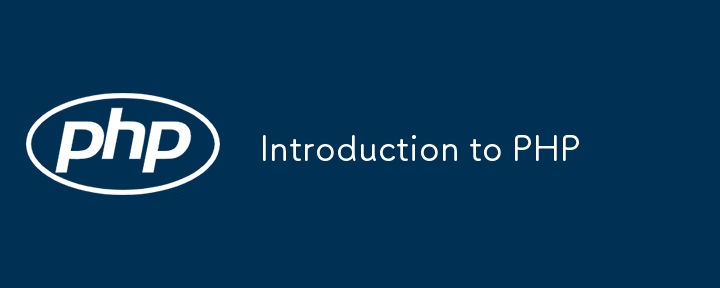Home >Backend Development >PHP Tutorial >Introduction to PHP
Introduction to PHP
- WBOYWBOYWBOYWBOYWBOYWBOYWBOYWBOYWBOYWBOYWBOYWBOYWBOriginal
- 2024-08-26 22:30:411227browse

PHP
PHP (Hypertext Preprocessor) is a widely-used open-source scripting language, particularly suited for web development. It can be embedded into HTML and can generate dynamic web page content. The simplicity and flexibility of PHP make it a popular choice among developers.
Features of PHP
- Open-source: PHP is free to use and distribute.
- Cross-platform: PHP can run on multiple operating systems, such as Windows, Linux, and macOS.
- Database support: PHP supports various databases, such as MySQL, PostgreSQL, and SQLite.
- Community support: There are abundant documentation and community resources available for learning and troubleshooting.
Basic Syntax
PHP Files
PHP code is typically saved in files with the .php extension. PHP code can be embedded within HTML, and the server will execute the PHP code when processing the request and return the result.
<?php echo "Hello, World!"; ?>
Variables
In PHP, variables start with a dollar sign ($) followed by the variable name. Variable names can contain letters, digits, and underscores, but cannot start with a digit.
<?php $name = "John"; $age = 30; echo "Name: $name, Age: $age"; ?>
Data Types
PHP supports various data types, including:
- String
- Integer
- Float
- Boolean
- Array
- Object
Control Structures
PHP supports various control structures, including conditional statements and loops.
Conditional Statements
<?php
if ($age >= 18) {
echo "Adult";
} else {
echo "Minor";
}
?>
Loops
<?php
for ($i = 0; $i < 5; $i++) {
echo $i;
}
?>
Functions
Functions are reusable code blocks in PHP that can be called by name. PHP has many built-in functions, and you can also define custom functions.
<?php
function greet($name) {
return "Hello, $name!";
}
echo greet("Alice");
?>
Arrays
Arrays are variables that can store multiple values. PHP supports indexed arrays and associative arrays.
Indexed Arrays
<?php
$colors = array("Red", "Green", "Blue");
echo $colors[0]; // Output: Red
?>
Associative Arrays
<?php
$ages = array("John" => 25, "Alice" => 30);
echo $ages["John"]; // Output: 25
?>
Object-Oriented Programming
PHP supports object-oriented programming (OOP), allowing developers to create classes and objects.
Classes and Objects
<?php
class Car {
public $color;
function __construct($color) {
$this->color = $color;
}
function getColor() {
return $this->color;
}
}
$myCar = new Car("Red");
echo $myCar->getColor(); // Output: Red
?>
The above is the detailed content of Introduction to PHP. For more information, please follow other related articles on the PHP Chinese website!

